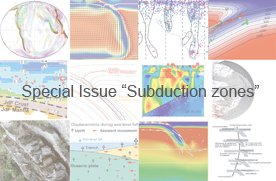Subduction to the lower mantle – a comparison between geodynamic and tomographic models
Abstract. It is generally believed that subduction of lithospheric slabs is a major contribution to thermal heterogeneity in Earth's entire mantle and provides a main driving force for mantle flow. Mantle structure can, on the one hand, be inferred from plate tectonic models of subduction history and geodynamic models of mantle flow. On the other hand, seismic tomography models provide important information on mantle heterogeneity. Yet, the two kinds of models are only similar on the largest (1000 s of km) scales and are quite different in their detailed structure. Here, we provide a quantitative assessment how good a fit can be currently achieved with a simple viscous flow geodynamic model. The discrepancy between geodynamic and tomography models can indicate where further model refinement could possibly yield an improved fit. Our geodynamical model is based on 300 Myr of subduction history inferred from a global plate reconstruction. Density anomalies are inserted into the upper mantle beneath subduction zones, and flow and advection of these anomalies is calculated with a spherical harmonic code for a radial viscosity structure constrained by mineral physics and surface observations. Model viscosities in the upper mantle beneath the lithosphere are ~1020 Pas, and viscosity increases to ~1023 Pas in the lower mantle above D". Comparison with tomography models is assessed in terms of correlation, both overall and as a function of depth and spherical harmonic degree. We find that, compared to previous geodynamic and tomography models, correlation is improved, presumably because of advances in both plate reconstructions and mantle flow computations. However, high correlation is still limited to lowest spherical harmonic degrees. An important ingredient to achieve high correlation – in particular at spherical harmonic degree two – is a basal chemical layer. Subduction shapes this layer into two rather stable hot but chemically dense "piles", corresponding to the Pacific and African Large Low Shear Velocity Provinces. Visual comparison along cross sections indicates that sinking speeds in the geodynamic model are somewhat too fast, and should be 2 ± 0.8 cm yr−1 to achieve a better fit.






